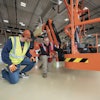
By Jim Arabia
Latest government figures show spending on construction peaked at $1.3 billion in August; however, there is still a huge hurdle facing contractors and hindering the current boom — the availability of qualified labor. The lack of skilled workers in the trade has been an ongoing problem, but the solution has not quite come to the forefront.
We have a lesson to learn from our counterparts in Europe where apprenticeship programs are widespread and trade schools or vocational training are seen as a great career path for many teens and young adults.
Most major, and even small, contractors in the UK run apprenticeship programs where the new hire learns on the job while also attending school, for example one day a week or evening classes.
Trades in every aspect of construction from bricklaying and carpentry to plumbing, electrics and civil engineering are available. The return on investment makes it a good option for the employer, as much as 25% on what they pay apprentices and the revenue profited from projects. Additionally, companies face reduced recruiting costs, a more predictable and reliable supply of skilled labor, improved employee retention and better productivity. The average age of a person in the building trades today is 50 so it’s easy to see why young blood is needed for our future.
In Switzerland, 70% of teens are apprentices, giving the country a steady stream of trained, experienced workers. Bear in mind, like the UK, Switzerland also offers apprenticeships in professional services industries like accounting, healthcare, aerospace and manufacturing.
In the U.S., trade schools and apprenticeships are often overlooked despite the potential for high wages, high demand and self-employment. Parents push their children towards a four-year college where the dropout rate is more than 40% and job opportunities are limited.
In comparison, trade schools, which take shorter time to complete and are more affordable, see dropout rates of as little as 1%. Yet, enrollments are falling fast. This is something that needs to be addressed.
We need to encourage a shift in focus for student learning and recruitment towards trades schools for those who don’t want to pursue a four-year college degree. These skilled workers will make a more relevant impact to the jobs market. It will also do better for the U.S. economy which currently has $1.4 trillion in student loans* and, according to the Department of Labor, seven million unfilled jobs.
Sam O’Neill, a 28-year-old former plumbing apprentice from the UK summed it up when said, “I knew I could never afford a four-year college so an apprenticeship program was my ideal choice. I loved learning on the job while going to trade school, and I’m still working for the same housebuilder. I feel a loyalty to them for investing in me. I recently just bought a house of my own. Many of my counterparts who went to university can’t afford to leave their parents’ home.”
Apprenticeship programs are unlike internships as the employee/student is paid for learning on the job while also attending college.
In many European countries, contractors receive government funding/reimbursements for the cost of the apprenticeship training. The apprentice must receive at least minimum wage and the community or trade colleges run associated courses. We’re seeing trade colleges in the U.S. also offering credits for employer funded apprenticeships. In fact, Forbes recently ranked the top 25 two-year trade schools. But we need more.
The construction industry along with support from government educational funds, such as the recently signed bi-partisan supported bill H.R.2353- Strengthening Career and Technical Education for the 21st Century Act, need to support more apprenticeship programs and better promote trade schools.
If we are to fill our shortage of skilled labor, then we need school counselors promoting vocational training and trade schools as much as four-year degrees. We need apprenticeship programs being viewed with the same respect as college degrees. And we need contractors to step up by offering robust apprenticeship programs and investing in long-term training. The figures speak for themselves in terms of benefit and reward. Studies show that the payback period for a firm sponsoring a typical apprenticeship in the UK is only three years for construction apprenticeships, and only four years for engineering apprenticeships.
A recent article in the Journal of Labor Policy supports our beliefs, “Empirical evidence shows that in a well-functioning apprenticeship training system, a large share of the training firms can recoup their training investments by the end of the training period. As training firms often succeed in retaining the most suitable apprentices, offering apprenticeships is an attractive strategy to recruit their future skilled workforce.”
The shortage of qualified workers is also pushing up wage costs. The Associated General Contractors of America report that in September the average hourly earnings went above $30 an hour for the first time, a 10% premium on the average for nonfarm private-sector jobs.
So, let’s all work together to be a driving force for a more skilled labor force for the construction industry.
*According to Credit Summit, student loan debt has increased to an all-time high of $1.7 trillion in 2021.
Jim Arabia, is VP of Marketing at BigRentz, an online construction equipment rental marketplace. It has 1,600+ rental partners and 8,000+ partner locations making it the largest equipment rental network in the nation, thus simplifying the procurement and logistics challenges of renting construction equipment.



















